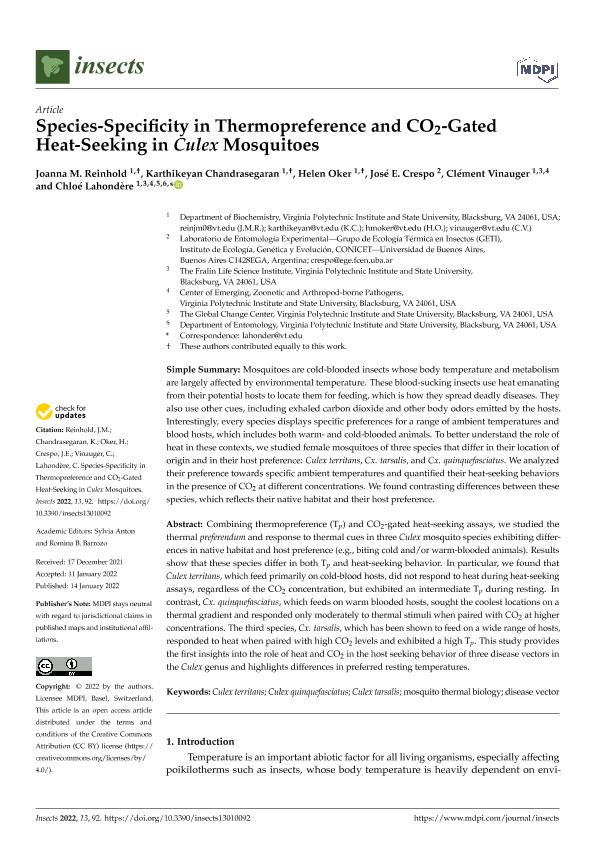Mostrar el registro sencillo del ítem
dc.contributor.author
Reinhold, Joanna M.
dc.contributor.author
Chandrasegaran, Karthikeyan
dc.contributor.author
Oker, Helen
dc.contributor.author
Crespo, José Emilio

dc.contributor.author
Vinauger, Clément
dc.contributor.author
Lahondère, Chloé
dc.date.available
2022-07-21T18:58:53Z
dc.date.issued
2022-01
dc.identifier.citation
Reinhold, Joanna M.; Chandrasegaran, Karthikeyan; Oker, Helen; Crespo, José Emilio; Vinauger, Clément; et al.; Species-specificity in thermopreference and CO2-gated heat-seeking in culex mosquitoes; Multidisciplinary Digital Publishing Institute; Insects; 13; 1; 1-2022; 1-18
dc.identifier.uri
http://hdl.handle.net/11336/162844
dc.description.abstract
Combining thermopreference (Tp) and CO2 -gated heat-seeking assays, we studied the thermal preferendum and response to thermal cues in three Culex mosquito species exhibiting differences in native habitat and host preference (e.g., biting cold and/or warm-blooded animals). Results show that these species differ in both Tp and heat-seeking behavior. In particular, we found that Culex territans, which feed primarily on cold-blood hosts, did not respond to heat during heat-seeking assays, regardless of the CO2 concentration, but exhibited an intermediate Tp during resting. In contrast, Cx. quinquefasciatus, which feeds on warm blooded hosts, sought the coolest locations on a thermal gradient and responded only moderately to thermal stimuli when paired with CO2 at higher concentrations. The third species, Cx. tarsalis, which has been shown to feed on a wide range of hosts, responded to heat when paired with high CO2 levels and exhibited a high Tp. This study provides the first insights into the role of heat and CO2 in the host seeking behavior of three disease vectors in the Culex genus and highlights differences in preferred resting temperatures.
dc.format
application/pdf
dc.language.iso
eng
dc.publisher
Multidisciplinary Digital Publishing Institute
dc.rights
info:eu-repo/semantics/openAccess
dc.rights.uri
https://creativecommons.org/licenses/by/2.5/ar/
dc.subject
CULEX QUINQUEFASCIATUS
dc.subject
CULEX TARSALIS
dc.subject
CULEX TERRITANS
dc.subject
DISEASE VECTOR
dc.subject
MOSQUITO THERMAL BIOLOGY
dc.subject.classification
Ecología

dc.subject.classification
Ciencias Biológicas

dc.subject.classification
CIENCIAS NATURALES Y EXACTAS

dc.title
Species-specificity in thermopreference and CO2-gated heat-seeking in culex mosquitoes
dc.type
info:eu-repo/semantics/article
dc.type
info:ar-repo/semantics/artículo
dc.type
info:eu-repo/semantics/publishedVersion
dc.date.updated
2022-07-20T15:16:30Z
dc.identifier.eissn
2075-4450
dc.journal.volume
13
dc.journal.number
1
dc.journal.pagination
1-18
dc.journal.pais
Suiza

dc.journal.ciudad
Basilea
dc.description.fil
Fil: Reinhold, Joanna M.. Virginia Polytechnic Institute; Estados Unidos. Virginia State University; Estados Unidos
dc.description.fil
Fil: Chandrasegaran, Karthikeyan. Virginia Polytechnic Institute; Estados Unidos. Virginia State University; Estados Unidos
dc.description.fil
Fil: Oker, Helen. Virginia Polytechnic Institute; Estados Unidos. Virginia State University; Estados Unidos
dc.description.fil
Fil: Crespo, José Emilio. Consejo Nacional de Investigaciones Científicas y Técnicas. Oficina de Coordinación Administrativa Ciudad Universitaria. Instituto de Ecología, Genética y Evolución de Buenos Aires. Universidad de Buenos Aires. Facultad de Ciencias Exactas y Naturales. Instituto de Ecología, Genética y Evolución de Buenos Aires; Argentina
dc.description.fil
Fil: Vinauger, Clément. Virginia Polytechnic Institute; Estados Unidos. Virginia State University; Estados Unidos
dc.description.fil
Fil: Lahondère, Chloé. Virginia Polytechnic Institute; Estados Unidos. Virginia State University; Estados Unidos
dc.journal.title
Insects
dc.relation.alternativeid
info:eu-repo/semantics/altIdentifier/url/https://www.mdpi.com/2075-4450/13/1/92
dc.relation.alternativeid
info:eu-repo/semantics/altIdentifier/doi/https://doi.org/10.3390/insects13010092
Archivos asociados
